

10 Activities for Teaching Animal Farm
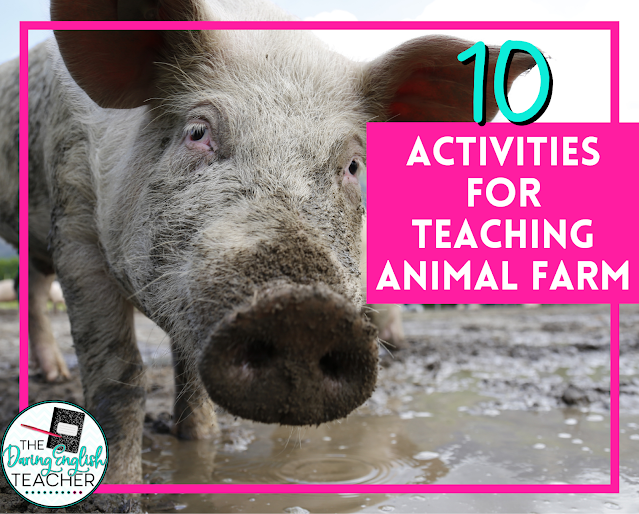
Animal Farm is such an “easy” read, but it’s also important and packed with themes and civics-related topics to discuss. If you’re looking for new ideas for teaching Animal Farm, read on. I’m excited to share these 10 activities with you.
1. Group Research Project
Instead of having a bunch of independent work for students to complete, get them into groups to share the load of research. This is perfect for switching up the monotony of worksheets and independent work. You can also use this as a differentiated option if you have students who may benefit from tackling research as a group rather than on their own. My group research project includes a final project of 5 paragraph essay with MLA formatting and a PowerPoint presentation. It’s an engaging option to set the historical context before reading Animal Farm OR you can use it as an extension activity after the novel.
2. Vocabulary Study
Having a grasp on the vocabulary is an important place to start with novel studies. Building useful vocabulary skills is honestly just something I feel is important in general for not only making meaningful connections, but it’s something students can continue to use beyond the unit. If you’re adding a vocabulary unit to your Animal Farm unit, consider this resource full of puzzles, quizzes, differentiated columns, and vocabulary terms for each chapter.
3. Chapter Writing Prompts
Second to vocabulary, I like to focus on characters. There are a lot of ways to go about character studies, but being an allegory, Animal Farm has a lot of great depth. Engage students with a variety of activities and writing prompts. Studying characters from a variety of angles is a great way to make sure students understand, and that you are helping students who need differentiated instruction. There are a lot of different activities you can do for character studies. You can look at rhetorical analysis, characterization, argument writing, allegory, and irony. I have an engaging writing prompt activity that covers all this and more.
4. Argument Essay
Being able to construct a good argument essay means students can investigate a topic, collect and evaluate their evidence, and establish a concise position. The allegory of Animal Farm is such a perfect novel to study argument writing and let students write their own. Check out this final argument essay that includes 2 rubrics and peer editing options, as well as essay outlines, graphic organizers, and a thesis generator to aid students in nailing the argument essay.
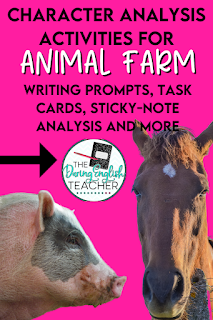
5. Speech Study
Major’s speech is a pivotal moment in Animal Farm. It is what inspires the rebellion and brings the animals together. His rhetorical skill is a perfect example to study speeches and help students understand ethos, pathos, and logos. If you’re not sure where to begin with a speech study project, I have five different activities that I use to help students understand and analyze Major’s speech. My packet includes excerpts for annotating, worksheets for key ideas, and explanations of ethos, pathos, logos, and the rhetorical triangle.
6. Character Analysis
Back to the characters with an analysis activity. There are so many characters in the novel and they all stand-in for the broader metaphor. Put together an analysis activity that will help students keep track of the characters and their purpose, as well as any other notes they may need to understand the text deeply. Think about the characterization from all angles. You can have students focus on whether characters are round or flat, static or dynamic, the main conflict for the character, and whether they are an antagonist or protagonist. But you can also go deeper and look at emotional development and motivation from the beginning of the novel to the end. Find both of these analysis options here .
7. Sticky Note Analysis
I’m a little bit obsessed with the sticky notes. First, they are super fun to bring out. There are color and shape options to offer variety to students. They offer a level of interaction. They are also a great way to guide students to be concise with their wording and thoughts when completing activities. Check out my Sticky Note Literary Analysis Activities for 11 organizers that can be used at any point in the novel. These are so perfect to help scaffold literary analysis. Five of my organizers also include built-in writing prompts.
8. Interactive Bookmarks
Looking for something simple and compact? Literally? Use bookmarks. They fit in the book and so serve a purpose as a bookmark. If students have their novels with them in class, they already have their work with them too. You can use a bookmark to study characters, list important quotes, create timelines of events, answer quiz questions, and more. I personally love this foldable bookmark that houses a variety of activities. I use three different bookmarks over the course of Animal Farm. Each is double-sided and has space for all of my activities. You can see it in action here .
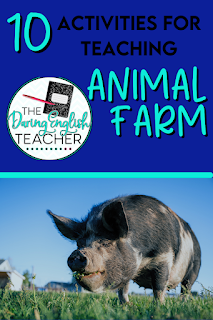
9. Short Responses and Task Cards
When you have task cards or short response activities, it opens up a variety of activities you can use. You can have students work on each aspect independently or in groups. You can easily adjust the wording to scaffold the learning for students. If you want students to get up and more around, you can make the task cards a gallery walk on craft paper. You can graffiti wall any short writing response. You can put questions on strips glued to Jenga tiles and have students play the game and answer as they go. This resource includes six detailed and higher-level response questions in a couple of different formats: writing task cards, discussion task cards, and paper-saving handouts.
10. Self-Graded Quizzes
Oh yeah, self-grading quizzes . I created these to run on Google Forms, and each chapter has a quiz. If you’re looking for something different to assess if students read the chapters, or you need some assessments for students working remotely, go grab this resource. It really takes the pressure off handling paper materials (also a great option if you’re looking for a greener classroom), it’s quick and super-efficient. Did I mention it also gathers the data into a Google Sheet for you? Still needing a paper option? Don’t worry, the resource comes with this option as well.
I love adding to my own toolbox with ideas to spruce up novel studies. What are your favorite activities when working with Animal Farm that your students love?
Leave a Reply Cancel reply
Your email address will not be published. Required fields are marked *
Save my name, email, and website in this browser for the next time I comment.

SUBSCRIBE NOW
Tips and ideas for teaching high school ELA
One of my favorite parts of British literature is teaching Animal Farm. It’s short. It’s accessible. It’s always a hit. One of the great things about Animal Farm is that there is more to it than meets the eye. At the surface level, it’s a fun novel (novella?) about a bunch of farm animals who grow tired of their alcoholic farmer/owner mistreating them, so they stage a coup and run him off. On a deeper level, it’s a wonderful allegory of the Russian Revolution and the beginnings of the Soviet Union. With topics of power and corruption, Orwell’s novel is an excellent tool for allegorical and literary analysis.
Below are some of my favorite ideas for teaching this classic allegorical novel.
Introducing animal farm: background/pre-reading
Before getting into the actual reading, I always started with some background information and context. I would review this presentation and have students take notes. My thought process was that students would be able to better understand the allegorical meaning of the text if they were able to recognize the historical counterparts and events.
I recently read, however, of a teacher who didn’t do any of the historical background until after the class has read the novel. This allows the students to focus on the literary analysis side without getting tripped up on trying to keep the allegorical characters straight. Next time I teach Animal Farm, I may try this method. Either way, historical background/context is vital.
I also like to start every novel unit with a little author biography to provide additional context. You can check out the Britannica biography of George Orwell here .
Another activity for teaching Animal Farm that my students really enjoyed was this Make Your Class Animal Farm lesson plan from Teachers.net. The last time I taught the novel I had a small class (special education resource), so this activity didn’t really work. My first time though? It was a huge success. The things high school students will do for some candy. It can be brutal.
The basic premise of the activity is this: the class is divided into groups – human, dog, raven, horse, or pig. Each group “runs” to become the leading party. Once the party is chosen, their privileges increase while their responsibilities decrease (similar to the novel). After students finish reading the novel, they do research on their historical counterparts:
- Pigs = Bolsheviks
- Dogs = White Russians
- Horses = Proletariats
- Humans = Tsars
- Ravens = Russian Church
during reading
You have the background information/context. Now for the fun part: reading.
Make Your Classroom Animal Farm
The great thing about this activity is that it lasts the entirety of the novel. The lesson plan breakdown covers six weeks, but could easily be adjusted to accommodate different schedules.
Student Workbooks
Have students interact with the novel using student workbooks. These workbooks were designed to engage students by allowing them to go beyond basic comprehension questions and dig into the novel.
Character Analysis
Animal Farm is ripe for character analysis. Have students analyze each character throughout the text. Alternately, assign students a specific character to focus on – even better if you can tie their character(s) into their “animal” from the Make Your Class Animal Farm project!
These character analysis graphic organizers are a perfect way for students to hone their analysis skills and provide textual evidence for their stances. Students provide examples of indirect characterization, chose and analyze a key quote, trace the character’s impact on theme development, and more.
Political Cartoons
One of the recurring motifs is the herd mentality of the sheep. A quick Google search will reveal tons of examples of political cartoons involving sheep. Have students use a method such as OPTIC to analyze the cartoons. This is also a great time to review satire. Then, have students use a program such as Canva to create their own political cartoons about a theme from the novel.
Film Adaptations
What student doesn’t love movie day? There are several film adaptations of Animal Farm – this 1999 live version . and this 1954 animated version.
after reading activities
It’s time to put it all together. Here are two of my favorite after-reading activities when teaching Animal Farm.
Escape Room
If you’re looking to bring some engagement and competition into your classroom, escape rooms are the way to go! (Read more about how to use escape rooms in the classroom here ).
During my last time teaching Animal Farm , students reviewed the novel by completing an escape room. They started off with their introduction – they were playing as an animal who lived through the Rebellion and Napoleon’s reign. Each of the four tasks (plot, characters, close reading, and encrypted message) moved them through a different stage of their life as this animal. The winning team got candy and a few extra points on their test. You want to see some cut-throat competition? Offer seniors peppermints and Jolly Ranchers
Soundtrack Project
Another review/wrap-up activity that has been met with great success is a soundtrack project. The great thing about this project is that it can be repurposed for any novel.
Students chose a minimum of 6 songs:
- 3 characters
They then create a soundtrack using songs that relate to each category. For each song, they had to include:
- song name and artist
- lyrics (they could just choose the ones that best fit the purpose)
- reasoning behind choosing the song
Other Resources for teaching animal farm
In addition to the novel itself, I like to bring in supplemental resources – especially in the way of nonfiction. If you’re looking for additional texts, check out CommonLit.org. They have a whole section of related texts for Animal Farm .
For connections to real life, check out this Life under Stalin video.
So there you have it. Some of my favorite activities for teaching Animal Farm .
Interested in student workbooks and escape room mentioned above? Check out the Animal Farm Unit Bundle.
Looking for more Brit Lit curriculum ideas? Check out 7 Units for a Complete Brit Lit Curriculum .
Want an editable British Literature Curriculum Map? Subscribe to the newsletter and grab your free scope and sequence today!
British Literature Curriculum Map/Scope & Sequence
Send me the free British Literature Curriculum Map!
You can unsubscribe anytime. For more details, review our Privacy Policy.
You have successfully joined our subscriber list.
Copyright l Windows into Literature l All Rights Reserved
- Create account
- About the Authors
- What is a Script-Story?
- Script-Stories: Making Reading an Experience Instead of a Struggle
- How To Use Script-Stories in the Classroom
- Reaching Olympus: How Script-Stories Brought Mythology To Life
- Improving Reading Comprehension with Script-Stories
- Why "Creative Teacher"?
- Teacher Testimonials
- Mythology for Teens vs. Reaching Olympus
- Learning the English Language
- Ancient Civilizations: Mesopotamia and Egypt
- The Bible As Literature
- Ancient Greece: Greek mythology, Oedipus Rex, and Antigone
- Ancient Rome: Roman mythology, Julius Caesar, and Spartacus
- Beowulf, Old English, and Anglo-Saxon Culture
- Knights, Chivalry, King Arthur, and the Knights of the Round Table
- Heaven and Hell: Dante's Inferno, the Medieval Church, and Legends of the Saints
- The Canterbury Tales, Robin Hood, and Everyday Life in the Middle Ages
- Utopia and Dystopia: The Sword in the Stone, Gulliver's Travels, and Robinson Crusoe
- Monsters: Frankenstein, Dracula, Dr. Jekyll, Jack the Ripper, Mr. Hyde
- George Orwell: Animal Farm, 1984, and Planet of the Apes
- Teaching Mythology
- How To Set Up a Mythology Course
- How To Become a Mythology Teacher
- Ancient Mythology: Gilgamesh and Egyptian Mythology
- Greek Mythology: The Gods and Heroes
- Greek Mythology: Gallery of the Gods
- Greek Mythology: The Trojan War, the Iliad, and the Odyssey
- Roman Mythology: The Aeneid and Ovid's Metamorphoses
- World Mythology: Tales from Around the World
- Norse Mythology
- King Arthur and the Knights of the Round Table
- Robin Hood Legends
- The Hero's Journey
- Mythical Creatures from Around the World
- Mythology for Kids
- Greek Mythology for Kids
- Teaching the American Dream
- How To Setup an American Literature Course
- The New World: Natives, Explorers, and Pilgrims
- Puritan Life: The Scarlet Letter, The Crucible, and the Salem Witch Trials
- Forming a Nation: The Last of the Mohicans, Washington Irving, and the Founding Fathers
- The American Imagination: Moby Dick, Edgar Allan Poe, and the Transcendentalists
- Slavery and Freedom: Frederick Douglass, Tom Sawyer, and Huck Finn
- Broken Dreams: The Great Gatsby, Of Mice and Men, and To Kill a Mockingbird
- Gamification Resources
- Science Fiction Short Stories
- Distance Learning Resources
- Presentations
- Teaching Literary Elements
- Writing and Paper Topics
- Scoring Guides and Grading Resources
- Another Great Script-Story Site

Creative English Teacher.com
- Why "Creative Teacher"?
- Heaven and Hell: Dante's Inferno, the Medieval Church, and Legends of the Saints
- Utopia and Dystopia: The Sword in the Stone, Gulliver's Travels, and Robinson Crusoe
- Roman Mythology: The Aeneid and Ovid's Metamorphoses
- The Hero's Journey
George Orwell: Animal Farm and 1984 Teaching Materials
Animal farm and 1984 by george orwell.
In our day and age when media plays such a large part in the way people think, everyone (and I do mean everyone) should read George Orwell's Animal Farm and 1984 . Orwell masterfully wraps his warnings about corrupt governments and the loss of human rights up inside intriguing and well-written tales. Below are some ways to make Animal Farm and 1984 more engaging and meaningful for your students.
KEY PLAYERS IN THE RUSSIAN REVOLUTION AND THE SOVIET UNION (PDF) This presentation gives a general overview of the key players in the Russian Revolution as well as the first leaders of the Soviet Union. This is helpful when asking students to spot parallels for these historical figures in the novel.
ANIMAL FARM CHAPTER READING QUIZZES (SALE ITEM) This download includes a 10-question, multiple-choice reading quiz for each of the ten chapters of Animal Farm by George Orwell. I have used these quizzes in my classroom for years, and I can vouch that they keep students accountable for their reading.
INTRODUCTION TO PROPAGANDA PRESENTATION (PDF) This presentation showcases propaganda from the World War II and Cold War era. Some of the propaganda is pro-Nazi and antisemitic in nature, so teacher discretion is advised.
HUMOROUS PROPAGANDA EXAMPLES (PDF) These images spoof propaganda posters by using references to pop culture (Star Wars, Disney films, etc.)
AESOP'S FABLES This collection of classic fables shows students the idea of using animal stories to demonstrate human problems. If time allows, it is always a fun assignment to have students dramatize one of these fables.
JAMES THURBER FABLES These excerpts from Fables For Our Time by James Thurber are hilarious parodies of the fable genre. They are also interesting comments on our society.
ANIMAL FARM ACTION FIGURE (PDF) This assignment asks students to design an action figure based on a character from Animal Farm. Each action figure must have actions it performs, accessories, a vehicle, etc. This is a non-threatening way to ask students to analyze the characters of the novel and incorporate a little artwork in the process.
STUDENT SCHOOL (PDF) This assignment asks students to imagine that they have been given absolute control of their high school. The teachers are driven away, and the student body is under their complete control. What now? (This assignment always gets some interesting responses from my students.)

PLANET OF THE APES DISCUSSION QUESTIONS (PDF) These discussion questions are a great post-film assignment.
ORWELL, ANIMAL FARM, AND PLANET OF THE APES QUOTE POSTERS (PDF) These are nothing fancy, but if you print them out on colored paper, they make nice wall decorations. Make sure your students realize they are examples of verbal irony!
"NOTHING TO ENVY" EXCERPTS: LIFE IN NORTH KOREA (PDF) These excerpts from Nothing to Envy: Ordinary Lives in North Korea by Barbara Demick give haunting glimpses into the Orwellian world of North Korea. This makes a great follow-up activity for the novel. Read the whole book if you have time! To purchase the book or read more about it, visit Amazon.com by clicking here.
"THE FIREBIRD AND PRINCESS VASILISSA" (PDF) This is a Reader's Theater script-story of a famous Russian folktale. This tale gives a glimpse into the culture of Imperial Russia.
STALIN: RED TERROR DOCUMENTARY QUESTIONS (PDF) A&E Biography produced an excellent documentary on Stalin's rise to power. These questions progress in order and follow the details of the video. To purchase or read more about this documentary about Joseph Stalin, visit Amazon.com by clicking here.
RASPUTIN: THE MAD MONK DOCUMENTARY QUESTIONS (PDF) A&E Biography has produced an excellent documentary on the life of Grigory Rasputin. These questions progress in order and follow the details of the video. Rasputin's life shows much of what was corrupt and unstable about Imperial Russia--flaws that led to the overthrow of the government. To purchase or read more about the A&E Biography of Rasputin, visit Amazon.com by clicking here.
"GOD SEES THE TRUTH, BUT WAITS" BY LEO TOLSTOY AND READING GUIDE QUESTIONS (PDF) This classic short story introduces students to the world of Imperial Russia, the unfair treatment of Russian subjects, and the treatment of prisoners in Siberia.
"THE SIGNAL" (PDF) This classic short story shows the lives of two peasants--one who is content with being a peasant and another who considers terrorism as an alternative.
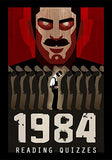
1984 READING QUIZZES (SALE ITEM) These 14 classroom-tested reading quizzes divide the novel up into manageable reading assignments and then assess the material. Each quiz has 10 multiple-choice questions (lettered A-D) that ask recall and inference questions related to the text. These are the same reading quizzes I have used in my own classroom, and they are as Sparknotes-proof as you can find. Keys with similar format are included as well for simple side-by-side grading.
- Lesson Plans
- Teacher's Guides
- Media Resources
Animal Farm : Allegory and the Art of Persuasion
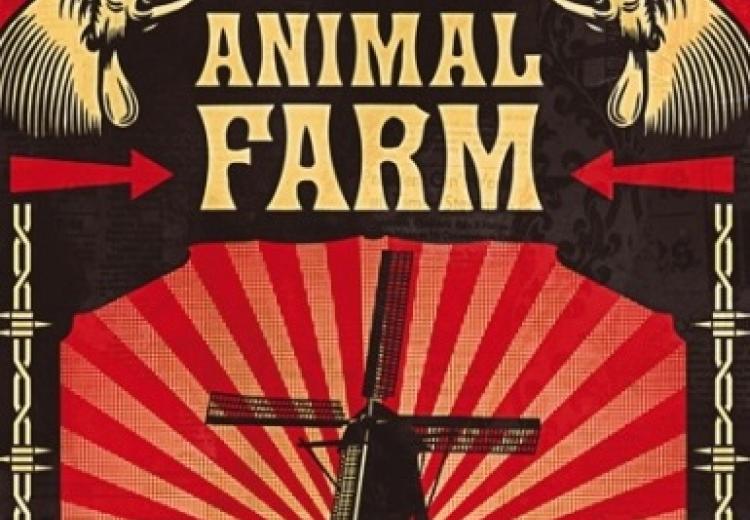
Cover of Animal Farm (1945) by George Orwell (2008 edition).
Allegories are similar to metaphors: in both the author uses one subject to represent another, seemingly unrelated, subject. However, unlike metaphors, which are generally short and contained within a few lines, an allegory extends its representation over the course of an entire story, novel, or poem. This lesson plan will introduce students to the concept of allegory by using George Orwell’s widely read novella, Animal Farm , which is available online through Project Gutenberg.
Guiding Questions
What are allegories and how are they used in literature?
What makes an allegory effective?
Why is Orwell's Animal Farm an allegory?
Learning Objectives
Assess the allegories used in George Orwell’s Animal Farm.
Explain how allegories operate as a rhetorical device.
Evaluate the social and political significance of Animal Farm .
Lesson Plan Details
At the time when Animal Farm was published in the 1940s the rule of Joseph Stalin in the Soviet Union and events in Ukraine and Georgia, as well as other places throughout Eastern Europe, would have been familiar to the average reader. This background knowledge will help to make the allegorical structure of Orwell’s novella clear to students. This lesson plan can be adapted to expand on history and social studies lessons which focus on this time period.
Allegory can be found both in literature and in the visual arts, such as painting and sculpture. Like metaphors, allegories utilize one subject as if it were analogous to another, seemingly unrelated, subject. Unlike metaphors, the representational image is more detailed and is sustained throughout the length of a story, novel, or poem. Allegories are generally understood as rhetorical, and, as a form of rhetoric, are generally designed to persuade their audience. More information about allegories and rhetoric is accessible through EDSITEment's Literary Glossary .
CCSS.ELA-LITERACY.CCRA.R.1. Read closely to determine what the text says explicitly and to make logical inferences from it; cite specific textual evidence when writing or speaking to support conclusions drawn from the text.
CCSS.ELA-LITERACY.CCRA.R.2. Determine central ideas or themes of a text and analyze their development; summarize the key supporting details and ideas.
CCSS.ELA-LITERACY.CCRA.R.4. Interpret words and phrases as they are used in a text, including determining technical, connotative, and figurative meanings, and analyze how specific word choices shape meaning or tone.
CCSS.ELA-LITERACY.CCRA.R.6. Assess how point of view or purpose shapes the content and style of a text.
In this lesson students will focus on George Orwell’s Animal Farm as an example of this rhetorical device, as it is perhaps the most widely read allegory in the middle school and high school classrooms. Orwell’s 1945 novella is an allegorical indictment of tyranny which utilizes the historical events and players of the Russian Revolution and the subsequent rise of Stalin as a cautionary tale. This lesson can be taught in conjunction with a close reading of the text, or it can be used to introduce the concept of allegory. Other well known allegorical texts include Edmund Spenser’s The Faerie Queen , William Golding’s The Lord of the Flies , and John Bunyan’s The Pilgrim’s Progress .
- Review and bookmark the web pages containing definitions for allegory and rhetoric , as well as the text of George Orwell’s Animal Farm .
- A complete audiobook is available.
- The 1954 cartoon film of Animal Farm (70 minutes) is available.
Activity 1. Animal Farm and Allegory
George Orwell’s 1945 novella, Animal Farm , is the story of an animal revolution. The animal residents of Manor Farm, spurred on by the dream of the pig, Old Major, decide they will change their “miserable, laborious, and short” lives. They overthrow Mr. Jones, their master, and take over the management of the farm. Rather than living under the heel of their human master, the animals of Manor Farm decide that they will take control of the products of their labor, working for the good of the farm and other animals, rather than for the good of humans.
How is this story allegorical? You may provide your own definition of allegory, or you can ask your students to read the definition of allegory that is available through EDSITEment's Literary Glossary . If an allegory is “a n extended metaphor in which characters and objects hold both a literal meaning as well as a secondary, implied meaning, ” then what is the additional or alternative meaning contained in Orwell’s story of animal rebellion?
Activity 2. The Collective Farm and the Communist State
Many of the events at Manor Farm are closely linked to political events in Russia during the first half of the twentieth century. The rebellion by the working animals of the farm against the oppressive human farmer who lives off the fruits of their labor is directly analogous to the Russian Revolution of 1917 in which workers and peasants revolted against a feudal system in which feudal lords lived luxuriously from the toil of the peasants who farmed on their lands. If your students are not already familiar with some of the main events of Russian history from the turn of the twentieth century to the end of World War II, you may wish to have them read an overview of the history of the Soviet Union .
Ask students to answer the following questions about the events that take place on the Manor Farm, and how they are an allegorical retelling of the events from the Russian Revolution to the end of World War II in Russia.
- How is Orwell’s Animal Farm an allegorical retelling of the end of feudalism and the rise and consolidation of communism in Russia?
- How does Orwell parallel Czarist Russia and the life of the Russian peasants in the characters and events of Animal Farm ?
- What internal feud within the Communist party is paralleled in the struggle for power between Napoleon and Snowball?
- During the Stalinist period the Communist State repeatedly set industrial and agricultural production goals that were often difficult or impossible to reach. These goals played a major role in the government’s Five Year Plan and similar plans. How are these plans represented in Orwell’s novella?
Activity 3. What's in a Name?
Many of the characters in Animal Farm are clearly meant to represent historical figures. The human inspiration for Orwell’s fictional characters can often be found in the characters’ parallel actions, and sometimes even in their names. As an important structural component of the novella as an allegorical tale, each of the characters in the story is representative of players in the historical narrative the story represents.
After discussing with the class the trajectory of the Russian revolution and subsequent Communist Party fracturing, ask students to work in pairs on the characters of Animal Farm . If students are less familiar with the historical context, or if this lesson is not being taught in conjunction with a close reading of the Orwell text, you may prefer to work on completing this chart together as a class.
Once students have filled out their charts ask them to think about the names of each of the characters. What importance and symbolism is contained in Orwell’s choice of names? Draw their attention to Napoleon and Boxer in particular.
Finally, ask students to answer the following questions:
- What is the metaphor at the heart of Orwell’s allegorical tale?
- How do the characters support the larger allegory of the story?
- How is Orwell’s choice of animal and name for each character important in contributing to the larger story?

Activity 4. Tyranny by any other Name...
Orwell’s Animal Farm and 1984 , are often cited as works that are designed to show the weaknesses of Communism. These works took aim at the Soviet Union, however Orwell’s larger target was tyranny, in whatever form it appeared. He was as much concerned with the repression of rights and the injustice of the economic system in his own England as he was about Stalinist Russia.
As an allegorical tale about the dangers of tyranny, Orwell’s Animal Farm uses the story of Napoleon, Snowball, and Boxer as a form of rhetoric . Rhetoric can be understood as the use of language to persuade an audience of a belief or point of view. In the case of Animal Farm , Orwell is using the story of Manor Farm’s animal rebellion to caution people against the encroachment of tyranny. More information on rhetoric can be found in EDSITEment's Literary Glossary .
Ask students to contemplate the use of rhetoric in Animal Farm using the recommended questions :
- How is this allegorical tale also a rhetorical tale?
- What is Orwell trying to persuade the audience to see or understand?
- What is Orwell cautioning his audience against?
- How does the story of Boxer act as a persuasive argument against tyranny?
- What are the lessons to be learned from Napoleon’s behavior?
- What is the warning contained in the changes to the list of commandments?
- What is the lesson contained in the final, single commandment: All animals are equal but some animals are more equal than others?
Ask students to gather together their answers to the questions posed throughout this lesson, which they should then use as the basis for writing a short essay answer the following questions:
- How is Orwell’s Animal Farm an allegory, and what is in an allegory?
- What are the rhetorical components of this allegory?
- How is the use of allegory as a rhetorical device different from simply laying out a non-fictional account, or an historical or statistical analysis of the period and the rise of the Communist Party?
- How is Orwell’s use of allegory rhetorically successful?
Martin Niemoller was a church pastor in Germany during Hitler’s rise to power. He shifted from an early support of Hitler to being very outspoken against the Nazi agenda and practices. He was arrested and held in concentration camps throughout World War II, and barely escaped execution. He is now perhaps best known for his cautionary poem:
In Germany they came first for the Communists, and I didn't speak up because I wasn't a Communist. Then they came for the Jews, and I didn't speak up because I wasn't a Jew. Then they came for the trade unionists, and I didn't speak up because I wasn't a trade unionist. Then they came for the Catholics, and I didn't speak up because I was a Protestant. Then they came for me, and by that time no one was left to speak up.
Ask students to compare Niemoller’s cautionary poem with Orwell’s allegorical story of the Manor Farm. How are their messages similar or different? How is the method of delivering those message similar or different?
Materials & Media
Animal farm: worksheet 1 - animal farm and allegory, animal farm: worksheet 2 - what's in a name, animal farm: worksheet 3 - what's in a name (teacher version), animal farm: worksheet 4 - tyranny by any other name..., related on edsitement, a literary glossary for literature and language arts, george orwell's essay on his life in burma: "shooting an elephant", fiction and nonfiction for ap english literature and composition.

Home of The Brave
Animal farm chapter 2 creative writing: higher hw 2.
June came and the hay was almost ready for cutting. On Midsummer’s Eve, which was a Saturday, Mr. Jones went into Willingdon and got so drunk at the Red Lion that he did not come back till midday on Sunday. The men had milked the cows in the early morning and then had gone out rabbiting, without bothering to feed the animals. When Mr. Jones got back he immediately went to sleep on the drawing-room sofa with the News of the World over his face, so that when evening came, the animals were still unfed. At last they could stand it no longer. One of the cows broke in the door of the store-shed with her horn and all the animals began to help themselves from the bins. It was just then that Mr. Jones woke up. The next moment he and his four men were in the store-shed with whips in their hands, lashing out in all directions. This was more than the hungry animals could bear. With one accord, though nothing of the kind had been planned beforehand, they flung themselves upon their tormentors. Jones and his men suddenly found themselves being butted and kicked from all sides. The situation was quite out of their control. They had never seen animals behave like this before, and this sudden uprising of creatures whom they were used to thrashing and maltreating just as they chose, frightened them almost out of their wits. After only a moment or two they gave up trying to defend themselves and took to their heels. A minute later all five of them were in full flight down the cart-track that led to the main road, with the animals pursuing them in triumph. Mrs. Jones looked out of the bedroom window, saw what was happening, hurriedly flung a few possessions into a carpet bag, and slipped out of the farm by another way. Moses sprang off his perch and flapped after her, croaking loudly. Meanwhile the animals had chased Jones and his men out on to the road and slammed the five-barred gate behind them. And so, almost before they knew what was happening, the Rebellion had been successfully carried through: Jones was expelled, and the Manor Farm was theirs. For the first few minutes the animals could hardly believe in their good fortune. Their first act was to gallop in a body right round the boundaries of the farm, as though to make quite sure that no human being was hiding anywhere upon it; then they raced back to the farm buildings to wipe out the last traces of Jones’s hated reign. The harness-room at the end of the stables was broken open; the bits, the nose-rings, the dog-chains, the cruel knives with which Mr. Jones had been used to castrate the pigs and lambs, were all flung down the well. The reins, the halters, the blinkers, the degrading nosebags, were thrown on to the rubbish fire which was burning in the yard. So were the whips. All the animals capered with joy when they saw the whips going up in flames. Snowball also threw on to the fire the ribbons with which the horses’ manes and tails had usually been decorated on market days. Ribbons,' he said, should be considered as clothes, which are the mark of a human being. All animals should go naked.’ When Boxer heard this he fetched the small straw hat which he wore in summer to keep the flies out of his ears, and flung it on to the fire with the rest. In a very little while the animals had destroyed everything that reminded them of Mr. Jones. Napoleon then led them back to the store-shed and served out a double ration of corn to everybody, with two biscuits for each dog. Then they sang Beasts of England from end to end seven times running, and after that they settled down for the night and slept as they had never slept before.
Imagine you are one of the animals on the farm. Write an account of the animal’s rebellion from their perspective.
Include five examples of imagery, five examples of sound techniques (alliteration, rhyme, onomatopoeia, etc) and five examples of sentence structure techniques (list, repetition, long sentence, short sentence, etc).
Highlight each of them when you are done.
Leave a Reply
Your email address will not be published. Required fields are marked *
Save my name, email, and website in this browser for the next time I comment.

Resources you can trust
Animal Farm
George Orwell's iconic, dystopian novella is one of the most popular GCSE English Literature text choices, and it continues to provoke a strong reaction in English classrooms! With a range of games, quizzes, PowerPoints and worksheets to consolidate learning as well as thematic and chapter studies, you'll find plenty to inspire and engage learners.
Choose from Animal Farm worksheets, pre-reading tasks and lesson activities to explore the novel chapter by chapter, considering the presentation of England and Manor Farm, the wider historical context, and the influence of the Joseph Stalin, Lenin, Trotsky and the Russian revolution. Focus on the allegorical presentation of the main characters (Napoleon, Old Major, Snowball, Squealer, Boxer and Mr Jones) with visually appealing resources to bring the narrative to life.
You might also like to try our popular Animal Farm teaching pack for 20 lesson plans, targeted classroom resources and exam-style questions.
Resource collection
- (-) Show all (22)
- English (22)
- All key stages (22)
- (-) KS4 (22)
- All global tags (66)
- (-) Animal Farm (22)
- George Orwell (22)
- Post-1900 (18)
- Fiction (1)
- History (1)
Resource type
- Student activity (10)
- Worksheet (6)
- Teaching ideas (4)
- Game/quiz (3)
- Homework (3)
- Complete lesson (2)
- Exam preparation (2)
- Revision (2)
- Role play/debate/discussion (2)
- Starter/Plenary (1)
- All exam boards (2)
Search results
- Primary Hub
- Art & Design
- Design & Technology
- Health & Wellbeing
- Secondary Hub
- Citizenship
- Primary CPD
- Secondary CPD
- Book Awards
- All Products
- Primary Products
- Secondary Products
- School Trips
- Trip Directory
- Trips by Subject
- Trips by Type
- Trips by Region
- Submit a Trip Venue
Trending stories
Top results.

- 8 Great Teaching Tools For Reading George Orwells Animal Farm Ks4 English
8 great teaching tools for reading George Orwell’s Animal Farm in KS4 English
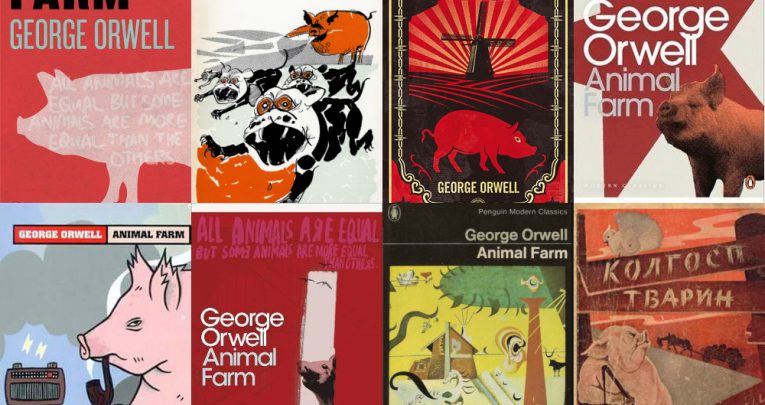
A collection of videos, pics and other resources to help spark a revolution of learning in your book topic…

Your students have probably been reading books about farmyard animals as far back as they can remember. Not, however, quite like this.
Animal Farm articulated the fear we all have that animals are poised, waiting for just the right moment to take over. You know, like a much cuter version of Planet of the Apes .
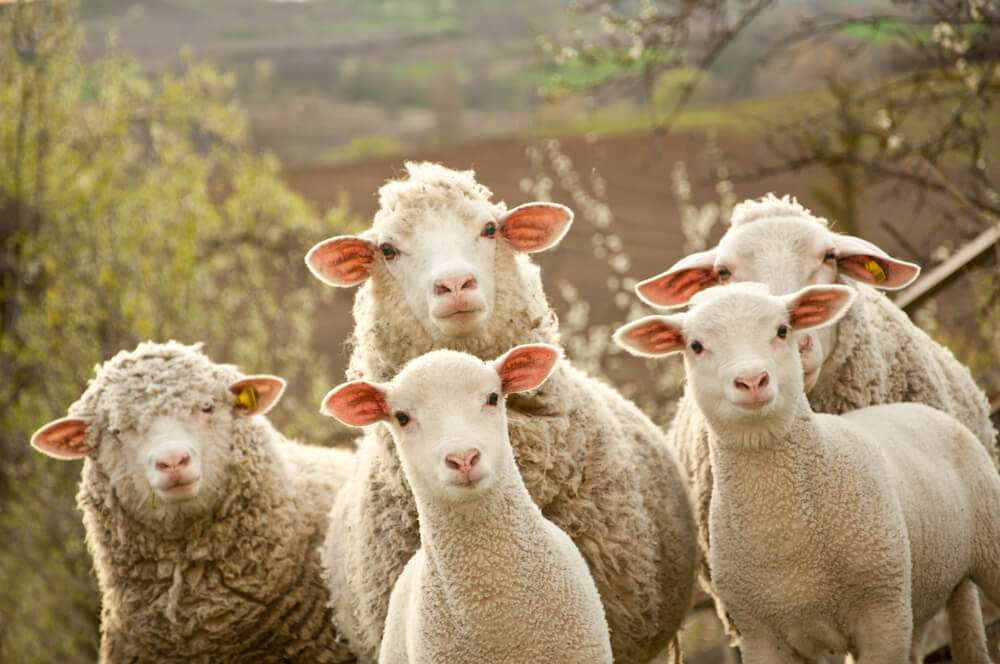
OK, so perhaps there’s more to it than that.
For many young readers Orwell is a first dalliance into politics – whether it’s this fairytale parable of Stalinist dictatorships, or 1984 , a dystopian parable of Stalinist dictatorships and how they betray true socialism.
These early steps into politics and allegory can be confusing for teenagers, which is why the classroom is the perfect setting for studying Orwell’s masterpieces – ‘So Orwell wrote two classic novels criticising the extreme left, but was still a democratic socialist?’ Yes. ‘So, extreme left bad, right also bad?’ Yes, welcome to the world of politics. Not much has changed.
‘And, four legs good, two legs bad?’ Yes, but we’ll get to that.
1 | The Russian Revolution
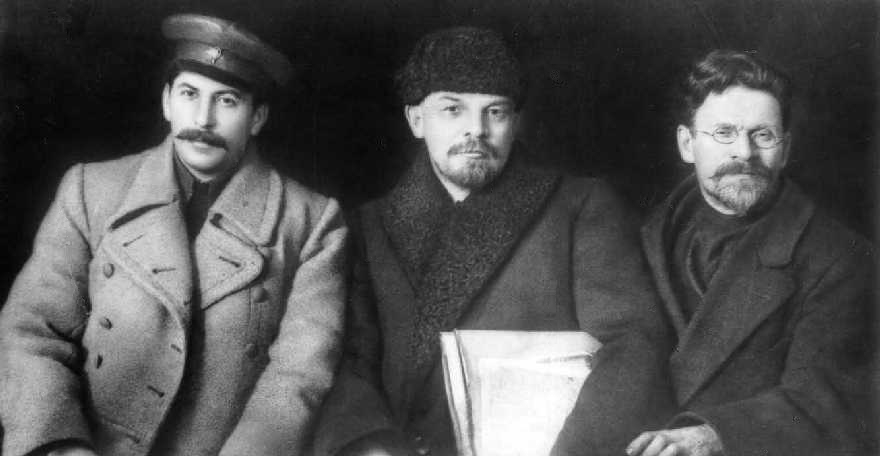
If you want to put the novel into political perspective the BBC Bitesize page has a great (and short) video that does the job nicely.
You can find it here.
2 | Visual character guide
And for a nice quick overview, with pictures, who the characters and their real-life counterparts, this video will do you nicely.
It’s not exactly hi-def though, so maybe one to watch on tablets rather than projected on a big screen in class.
And do enjoy the jazz score, and the bizarre abrupt shift from that into some country folksy guitar. Not that that matters much, just something I noticed.
3 | Character comparisons
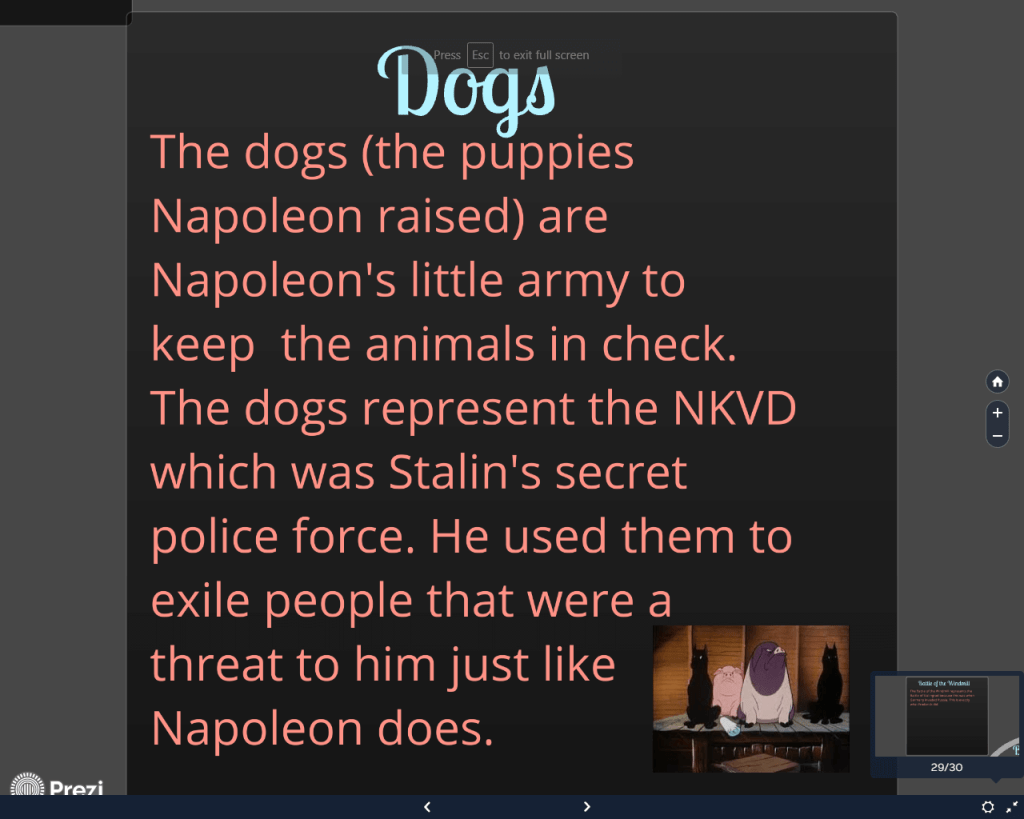
Alternatively, you can go into the character representations in more depth using this handy Prezi presentation .
4 | Why I Write
And for a bit more background about Orwell himself (which, of course, also puts the novel into context), this video does a great job in just under 14 minutes.
5 | Rejection letter
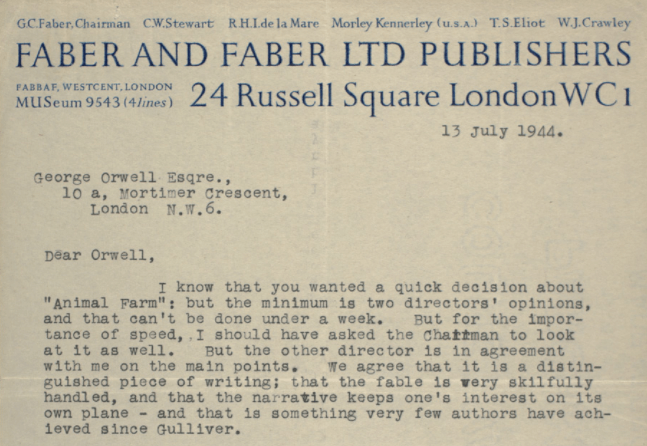
Something that might be fun to tie in to any political and ethical debate is the rejection letter for the book from Faber & Faber, which concludes on the point that actually the message from the novel is that ‘what was needed was not more Communism but more public-spirited pigs’.
If nothing else it’s a great example on why students shouldn’t necessarily take rejection to heart.
Read both pages of the letter here.
6 | Satire and symbols
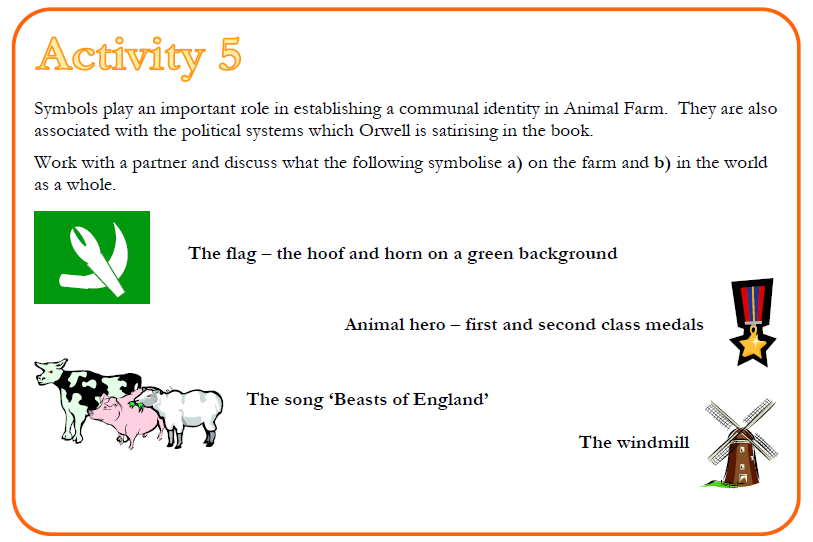
This PDF includes some activities on how Orwell uses language and style in Animal Farm , including rhetoric, irony, symbols, rhymes and the way political speeches are used to convince the masses that the party wants is in their best interest.
A handy tool for the book, and for life.
Click here to download.
7 | Propaganda and politics
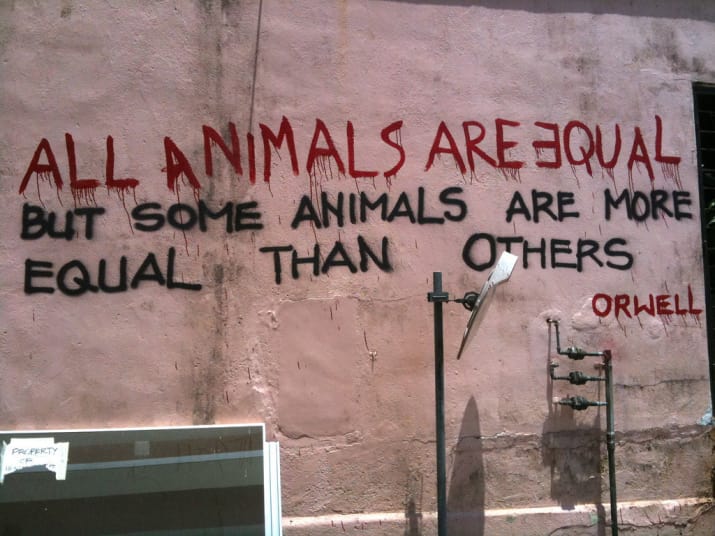
No study of Orwell is complete without looking at propaganda and the coercion of language for a political agenda.
This lesson plan is full of great things you can do on this front with Animal Farm , and includes an introduction to eight linguistic techniques commonly used in propaganda: name-calling, generalities, euphemisms, symbolism, testimony, fear, the ‘bandwagon’ trick (‘everyone else is doing it’) and convincing the audience that the powers that be are ‘one of them’.
Check out the activities here.
8 | Propaganda techniques
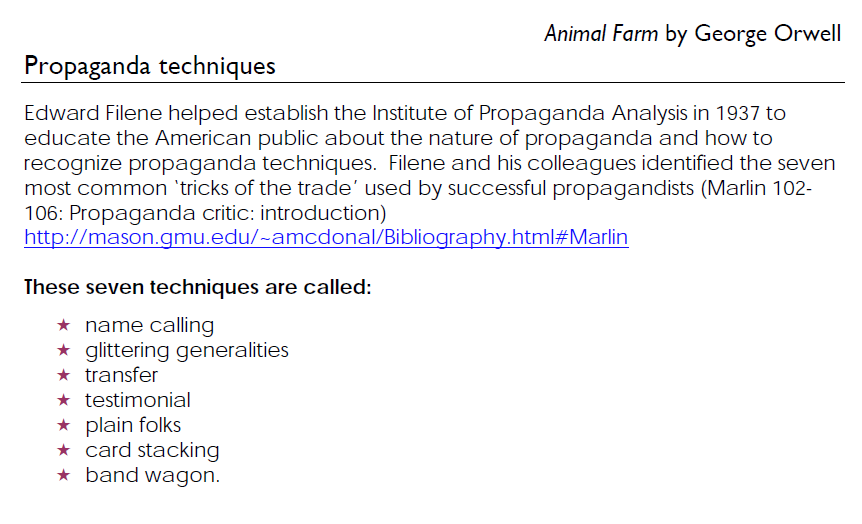
And you can find a more in-depth study of these techniques and how they relate to the text (including two tasks for students to tackle) here .
Additional resources
As a bonus, this excellent addition was suggested to us via Twitter:
Animal Farm preface cut by publisher. https://t.co/IMnWg7EoUJ — Gavin Boyd (@gavinboyd2012) November 11, 2017
Browse resources for Banned Books Week and more revision resources for GCSE English Literature .
Sign up to our newsletter
You'll also receive regular updates from Teachwire with free lesson plans, great new teaching ideas, offers and more. (You can unsubscribe at any time.)
Which sectors are you interested in?
Early Years
Thank you for signing up to our emails!
You might also be interested in...

Why join Teachwire?
Get what you need to become a better teacher with unlimited access to exclusive free classroom resources and expert CPD downloads.
Exclusive classroom resource downloads
Free worksheets and lesson plans
CPD downloads, written by experts
Resource packs to supercharge your planning
Special web-only magazine editions
Educational podcasts & resources
Access to free literacy webinars
Newsletters and offers
Create free account
By signing up you agree to our terms and conditions and privacy policy .
Already have an account? Log in here
Thanks, you're almost there
To help us show you teaching resources, downloads and more you’ll love, complete your profile below.
Welcome to Teachwire!
Set up your account.
Lorem ipsum dolor sit amet consectetur adipisicing elit. Commodi nulla quos inventore beatae tenetur.
I would like to receive regular updates from Teachwire with free lesson plans, great new teaching ideas, offers and more. (You can unsubscribe at any time.)
Log in to Teachwire
Not registered with Teachwire? Sign up for free
Reset Password
Remembered your password? Login here

Animal Farm Chapter 4 Post-Reading Creative Narrative Writing Prompts

What educators are saying
Also included in.
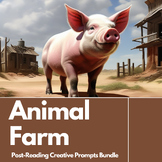
Description
Elevate your Animal Farm Chapter 4 lessons with these engaging and stimulating creative writing prompts. Ideal for classroom activities, homework assignments, literary analysis exercises, and alternative lesson plans, these prompts will encourage your students to explore the themes and ideas presented in Chapter 4 of the novel. Centered around characters, concepts like rebellion, oppression, and the quest for freedom, these writing prompts promote critical thinking and imaginative storytelling. Elevate your teaching with these thought-provoking prompts that empower students to connect with the text on a deeper level.
The download includes the following:
★ A list of all 10 prompts for Chapter 4
★ Individual handouts for each prompt on which students can write their creative pieces.
Some examples of the prompts are:
➤ Rewrite the Battle of the Cowshed from the point of view of Mr Jones. Use a range of language and sentence structures to convey the confusion during this moment of the novel.
➤ Write an interview with one of the pigeons who was sent out to spread the word about Animal Farm and teach other animals "Beasts of England." Describe the challenges they faced during this mission.
With such a wide range of prompts, students can choose their own challenge, or you can assign specific prompts to differentiate for students of varying levels. Don't miss out on this invaluable resource for teaching Orwell's Animal Farm in your English language arts or literature classroom. These writing prompts are sure to engage your students and help them get the most out of their reading of Chapter 4 of Animal Farm !
If you are looking for more resources for Animal Farm , then check out:
★ Animal Farm Roll the Dice Discussion Boards
★ Animal Farm Review Bingo
★ Animal Farm Post-Reading Creative Review Tasks
★ Animal Farm Post-Reading Creative Writing Bundle
★ Animal Farm Review Crossword
If you are looking for more resources based on the texts you teach, then check out:
★ Of Mice and Men Post-Reading Creative Writing Bundle
★ Macbeth Post-Reading Creative Writing Bundle
★ The Landlady Post-Reading Creative Writing Prompts
★ Twelfth Night Post-Reading Creative Writing Bundle
Thank you so much for checking out this product! If you want to show your support and stay up to date with my latest resources, you should:
♡ Follow my TPT store
♡ Follow me on Pinterest
♡ Leave a review if you loved your new resources!
Questions & Answers
- We're hiring
- Help & FAQ
- Privacy policy
- Student privacy
- Terms of service
- Tell us what you think


Dystopia Creative Writing
Subject: English
Age range: 11-14
Resource type: Lesson (complete)
Last updated
18 April 2024
- Share through email
- Share through twitter
- Share through linkedin
- Share through facebook
- Share through pinterest

Dystopia Creative Writing (KS3)
FREE - Lesson One:
Bundle SoW:
FREE Animal Farm SoW: https://www.tes.com/teaching-resource/resource-12942163
Leave a review for a FREE single resource
This SoW is designed in detail and is both differentiated and engaging, and allows you to move pupils through content efficiently.
Made to the highest standard and constructed using current research, both dual coding and retrieval practices are at the heart of this unit.
SoW: Dystopia Creative Writing (KS3)
L1 Utopia vs Dystopia L2 Conventions of Dystopian Fiction L3 I,_Robot L4 Dystopian worlds L5 Back to the Future descriptive L6 Creating dystopian fiction L7 Dystopia creative writing L8 Time Capsules and the Future L9 Landmarks before and after L10-11 Final Assessment L12 The Future – Assessment Writing L13 Star Trek L14 Preparing Presentations L15 Dragons’ questions. L16 DIRT L17 Film pitch L18 V for Vendetta L19 The Landlady
If you leave a review of any of our resources, you can claim any FREE single resource from our ever growing library. Simply message the above email, which is monitored daily.
I hope you find this SoW useful. If you have, I have created a series of resources. You can check them out here.
https://www.tes.com/teaching-resources/shop/TeacherCentral
Creative Commons "NoDerivatives"
Get this resource as part of a bundle and save up to 87%
A bundle is a package of resources grouped together to teach a particular topic, or a series of lessons, in one place.
Dystopia Creative Writing (KS3) L2 Conventions of Dystopian Fiction FREE - Lesson One: https://www.tes.com/teaching-resource/-12946524 Bundle SoW: https://www.tes.com/teaching-resource/dystopia-creative-writing-12946526 FREE Animal Farm SoW: https://www.tes.com/teaching-resource/resource-12942163 Leave a review for a FREE single resource This SoW is designed in detail and is both differentiated and engaging, and allows you to move pupils through content efficiently. Made to the highest standard and constructed using current research, both dual coding and retrieval practices are at the heart of this unit. SoW: Dystopia Creative Writing (KS3) L1 Utopia vs Dystopia L2 Conventions of Dystopian Fiction L3 I,_Robot L4 Dystopian worlds L5 Back to the Future descriptive L6 Creating dystopian fiction L7 Dystopia creative writing L8 Time Capsules and the Future L9 Landmarks before and after L10-11 Final Assessment L12 The Future – Assessment Writing L13 Star Trek L14 Preparing Presentations L15 Dragons’ questions. L16 DIRT L17 Film pitch L18 V for Vendetta L19 The Landlady If you leave a review of any of our resources, you can claim any FREE single resource from our ever growing library. Simply message the above email, which is monitored daily. [email protected] Best **FREE** Resources (Teacher Central) * https://www.tes.com/teaching-resource/britain-losing-and-gaining-an-empire-12973075 * https://www.tes.com/teaching-resource/financial-literacy-12898983 * https://www.tes.com/teaching-resource/romeo-and-juliet-12908635 * https://www.tes.com/teaching-resource/shakespeare-12908634 * https://www.tes.com/teaching-resource/macbeth-gcse-12863697 * https://www.tes.com/teaching-resource/animal-farm-free-sow-12942163 (FREE SoW) * https://www.tes.com/teaching-resource/slavery-sow-12843084 (FREE SoW) * https://www.tes.com/teaching-resource/russia-1917-91-from-lenin-to-yeltsin-12834552 * https://www.tes.com/teaching-resources/shop/TeacherCentral?sortBy=lowestPrice&p=5 I hope you find this SoW useful. If you have, I have created a series of resources. You can check them out here. https://www.tes.com/teaching-resources/shop/TeacherCentral
Your rating is required to reflect your happiness.
It's good to leave some feedback.
Something went wrong, please try again later.
This resource hasn't been reviewed yet
To ensure quality for our reviews, only customers who have downloaded this resource can review it
Report this resource to let us know if it violates our terms and conditions. Our customer service team will review your report and will be in touch.
Not quite what you were looking for? Search by keyword to find the right resource:

IMAGES
VIDEO
COMMENTS
You can see it in action here. 9. Short Responses and Task Cards. When you have task cards or short response activities, it opens up a variety of activities you can use. You can have students work on each aspect independently or in groups. You can easily adjust the wording to scaffold the learning for students.
Animal Farm Lesson 1 - Creative Writing Intro. Subject: English. Age range: 11-14. Resource type: Lesson (complete) File previews. pptx, 2.5 MB. I use this lesson as an introduction to Animal Farm for KS3 or KS4 learners. I find it most suitable for KS3. It is linked to creative writing and is used before the students begin reading the book.
The great thing about this project is that it can be repurposed for any novel. Students chose a minimum of 6 songs: theme. setting. 3 characters. 1 event. They then create a soundtrack using songs that relate to each category. For each song, they had to include: song name and artist.
ANIMAL FARM AND 1984 BY GEORGE ORWELL. In our day and age when media plays such a large part in the way people think, everyone (and I do mean everyone) should read George Orwell's Animal Farm and 1984. Orwell masterfully wraps his warnings about corrupt governments and the loss of human rights up inside intriguing and well-written tales. Below are some ways to make Animal Farm and 1984 more ...
In this lesson students will focus on George Orwell's Animal Farm as an example of this rhetorical device, as it is perhaps the most widely read allegory in the middle school and high school classrooms. Orwell's 1945 novella is an allegorical indictment of tyranny which utilizes the historical events and players of the Russian Revolution and the subsequent rise of Stalin as a cautionary tale.
Key learning points. In this lesson, we will be introduced to the major characters in the novel and learn the word 'omniscient'. We will read the opening of the novel and consider how and why Orwell uses an omniscient narrator in the novel. This content is made available by Oak National Academy Limited and its partners and licensed under Oak ...
Animal Farm. by George Orwell. Our comprehensive Animal Farm lesson plan teaches not just reading comprehension but also history, politics, and critical thinking. Animal Farm learning objectives ...
Animal Farm Chapter 2 Creative writing: Higher HW 2. June came and the hay was almost ready for cutting. On Midsummer's Eve, which was a Saturday, Mr. Jones went into Willingdon and got so drunk at the Red Lion that he did not come back till midday on Sunday. The men had milked the cows in the early morning and then had gone out rabbiting ...
Farm Animal Information Writing Frames. Grandad's Farm Listen and Draw Worksheet 1 review. Explore more than 235 "Animal Farm Creative Writing" resources for teachers, parents and pupils. Instant access to inspirational lesson plans, schemes of work, assessment, interactive activities, resource packs, PowerPoints, teaching ideas at Twinkl!
A KS4 teaching pack for Animal Farm, with 20 lesson plans, ... 20 creative lessons; exam-style questions for AQA, Edexcel and OCR ... One of Orwell's goals in writing Animal Farm was to portray the Russian Revolution and show that often a rebellion doesn't change things for the 'workers', in fact they can often be worse off than before. ...
pdf, 904.36 KB. This low-prep, end-of-unit creative writing project is an engaging alternative to a traditional summative test on Animal Farm by George Orwell. Students will write ten journal entries from Benjamin's point of view, exploring the character's internal state throughout the course of the novel. This assessment requires more than ...
Elevate your Animal Farm Chapter 5 lessons with these engaging and stimulating creative writing prompts. Ideal for classroom activities, homework assignments, literary analysis exercises, and alternative lesson plans, these prompts will encourage your students to explore the themes and ideas presented in Chapter 5 of the novel.
Animal Farm Writing - Points Challenge. Subject: English. Age range: 11-14. Resource type: Lesson (complete) File previews. pptx, 606 KB. A set of creative writing tasks based around Animal Farm by George Orwell. Each task is worth 'points' and students must gain a certain amount of 'points' in the lesson. Creative Commons "Sharealike".
Animal Farm. George Orwell's iconic, dystopian novella is one of the most popular GCSE English Literature text choices, and it continues to provoke a strong reaction in English classrooms! With a range of games, quizzes, PowerPoints and worksheets to consolidate learning as well as thematic and chapter studies, you'll find plenty to inspire and ...
This lesson plan is full of great things you can do on this front with Animal Farm, and includes an introduction to eight linguistic techniques commonly used in propaganda: name-calling, generalities, euphemisms, symbolism, testimony, fear, the 'bandwagon' trick ('everyone else is doing it') and convincing the audience that the powers ...
Elevate your Animal Farm Chapter 4 lessons with these engaging and stimulating creative writing prompts. Ideal for classroom activities, homework assignments, literary analysis exercises, and alternative lesson plans, these prompts will encourage your students to explore the themes and ideas presented in Chapter 4 of the novel.
FC Saturn Moscow Oblast (Russian: ФК "Сатурн Московская область") was an association football club from Russia founded in 1991 and playing on professional level between 1993 and 2010. Since 2004 it was the farm club of FC Saturn Moscow Oblast. In early 2011, the parent club FC Saturn Moscow Oblast went bankrupt and dropped out of the Russian Premier League due to huge ...
Animals and Pets Anime Art Cars and Motor Vehicles Crafts and DIY Culture, Race, and Ethnicity Ethics and Philosophy Fashion Food and Drink History Hobbies Law Learning and Education Military Movies Music Place Podcasts and Streamers Politics Programming Reading, Writing, ...
Elektrostal , lit: Electric and Сталь , lit: Steel) is a city in Moscow Oblast, Russia, located 58 kilometers east of Moscow. Population: 155,196 ; 146,294 ...
Welcome to the 628DirtRooster website where you can find video links to Randy McCaffrey's (AKA DirtRooster) YouTube videos, community support and other resources for the Hobby Beekeepers and the official 628DirtRooster online store where you can find 628DirtRooster hats and shirts, local Mississippi honey and whole lot more!
Animal Farm - Creative project. Subject: English language learning. Age range: 14-16. Resource type: Worksheet/Activity. File previews. pptx, 638.6 KB. This is a summative project I created for my lower ability IGCSE English B students, which gives them a chance to revise some of the text types and conventions they need to have mastered for the ...
pptx, 1021.96 KB. This is a free resource for Animal Farm, designed for use specifically with the OCR Literature GCSE. All resources for the lesson are on the powerpoint which covers Chapter 1 and 2 with a blank slide between each lesson. Each lesson contains extended writing tasks, key passages to focus on and includes differentiation.
SoW: Dystopia Creative Writing (KS3) L1 Utopia vs Dystopia L2 Conventions of Dystopian Fiction L3 I,_Robot L4 Dystopian worlds L5 Back to the Future descriptive L6 Creating dystopian fiction L7 Dystopia creative writing L8 Time Capsules and the Future L9 Landmarks before and after L10-11 Final Assessment L12 The Future - Assessment Writing ...